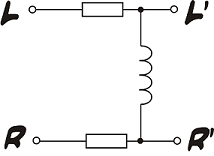
Neumann's legendary Elliptical equaliser. Just three impedances, but very cunning! The falling reactance of the inductor forces lower frequencies to mono so that bass is recorded onto a record as lateral modulation only

| This feature is due for release in Version 3.n of Stereo Lab |
The fragile, analogue medium of the vinyl LP record has a number of limitations compared with robust digital recoding media. Information is encoded on a gramophone record as "wiggles" in the spiral groove which runs from the outer edge of the record to the inner label. The cutting engineer's task is to maximise amplitude of these "wiggles", to get a signal recorded which is as far above the groove noise as possible without either damaging the medium, or the recording cutter head, or recording something which a stylus could never track on playback. It's a tightrope walk and it's a job made much harder by signals of certain characteristics. Amongst these are:
Now, the cutting engineer is well aware of these issues and has special equipment to deal with these signals when present: like steep-cut filters for the extreme bass and treble, and the mysterious Elliptical Equaliser.

But, if the engineer has to make significant changes to the signal, you either have to approve these, or, worse, he or she may play a bit safe and record the disc a bit quieter than it might have otherwise been. There's a whole host of other skills the mastering engineer has too, so by getting rids of obvious problems, you're maximising his or her time to concentrate on getting the very best performance from your record.
That is the intention of the Vinyl Pre-process in Stereo Lab.
The Vinyl Pre-process applies low and high-pass filters to limit the audio to reasonable bandwidth. These filters are all linear phase. In addition the left and right signals are fed to an exact digital model of Neumann's Elliptical Equaliser, which introduces crosstalk in the bass frequencies to force them to be mono (this reduces the out-of-phase part of the signal and limits the amplitude of the vertical groove modulation).
The Elliptical Equaliser in Stereo Lab will also be incorporated in the Groove algorithm when it is introduced, since part of the character of vinyl discs is determined by this, very significant signal manipulation.
 Home page
Home page
For all support issues, go here.
For Pspatial Audio sales, email: sales@pspatialaudio.com
